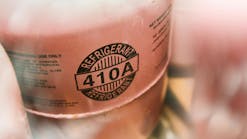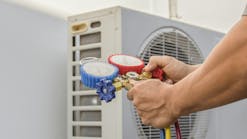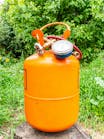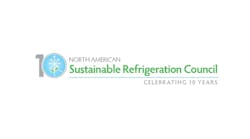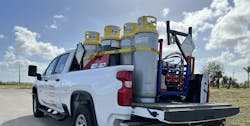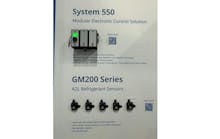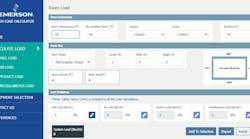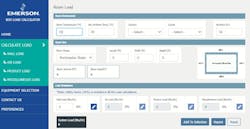REFRIGERATION SERVICE TODAY
Sizing and Selecting Condensing Units for Walk-in Coolers and Freezers
by Don Gillis
Walk-in coolers and freezers (WICFs) are used in a wide range of commercial and industrial applications — from supermarkets and restaurants to cold storage and processing plants. Because these units are built to support a variety of purposes, it’s important to select a remote condensing unit that can deliver the required refrigeration load and provide optimum system reliability and efficiency.
Sizing and selecting a condensing unit for a WICF application requires an understanding of every factor that could impact the refrigeration load, including: WICF construction and insulation envelopes; environmental conditions; and application-specific considerations. This article will look at these factors and evaluate the best practices and tools for calculating refrigeration load in order to select a properly sized condensing unit.
Heat transmission
WICFs can expect to take on a measure of heat gain through walls, floors, doors and ceilings depending upon a variety of factors, including:
- Construction type
- Insulation thickness
- Area exposed to ambient temperatures
- Temperature difference between the refrigerated space and the ambient air
To better understand these factors and help calculate refrigeration load, manufacturers of panels, doors and floors typically publish R-values (i.e., insulation ratings).
When determining the ambient temperature conditions, choosing the hottest possible temperature for a given region is not a recommended equipment design strategy. Should this temperature occur in that region, it may only happen for short durations over the span of several years. Thus, selecting a target peak demand design condition should be based on a percentage of the hours exceeding a reasonable maximum temperature range during a typical summer season.
WICF energy efficiency standards
Federal legislation is in place to drive energy-efficient WICF construction and mandate efficiency standards in WICFs. These include:
- Federal Energy Independence and Security Act of 2007 — designates WICF construction guidelines for air infiltration, insulation R-values, evaporator and condenser fan motor standards, lighting and much more.
- Department of Energy’s (DOE) Annual Walk-in Energy Factor (AWEF) — establishes minimum energy efficiency standards for several WICF equipment classes below the 3,000 square foot limit that must meet or exceed the minimum AWEF ratings based on capacity and application (e.g., medium- or low-temperature, indoor or outdoor)
Air infiltration
Air infiltration refers to the outside air entering the refrigerated space. WICF application requirements must be carefully evaluated to calculate the amount of air infiltration and its impacts upon the refrigeration load. When outside air is introduced, the condensing unit must reduce the WICF temperature to its cold storage setpoint, thus increasing the refrigeration load. In addition, if the moisture content of the infiltrating air is higher than the refrigerated space, its condensation will cause latent heat, which will increase the refrigeration load.
Because of these variables, it can be difficult to calculate the additional heat gain due to air infiltration. HVACR contractors have developed various means of estimating this portion of the refrigeration load, primarily based on personal experience. As a result, estimating air infiltration is subject to error, and specific applications may vary widely with respect to the actual heat gain encountered.
WICF design best practices — such as door curtains, automatic door closers and proper door gasket maintenance — are essential to minimizing air infiltration. It’s also important for contractors to install the evaporator unit cooler in a location that reduces the likelihood of it blowing chilled air out the door.
Product load
The product load refers to the heat gain that occurs when storing product in a refrigerated space. Product load can arise when a product enters the WICF at a higher temperature than the storage setpoint. The resultant chilling or freezing process necessary to “pull down” product temperatures increases product load, as can the heat of respiration of perishable products. Total product load is the sum of these various factors which may apply to a particular application.
Special applications, such as long-term perishable fruit apple storage, require more precise product load calculations. Different commodities have ideal cold storage temperatures and relative humidity to preserve freshness, quality and storage life. Refer to tables 13 and 14 in the Copeland™ Refrigeration Manual (AE 103) for recommended storage conditions of various perishable products, including cut flowers and nursery stock.
Supplemental load
In addition to heat transmission, air infiltration and product load, heat gain from other sources must also be included in the total cooling load estimate. Likely sources include:
- WICF lighting
- Fan/blower motors
- Employee foot traffic (open doors and/or body heat)
- Fork trucks (loading/unloading)
The impacts of foot traffic and fork trucks are especially important in larger cold storage warehouses, frozen food plants, loading docks, click-and-collect operations, or any environment with heavy walk-in or drive-in traffic.
Selecting a condensing unit
Once a contractor has determined the total refrigeration load, required evaporating temperature and expected condensing temperature, they can select a condensing unit for a given application. Refrigeration equipment selection is based upon refrigeration capacity, considering the expected compressor operating time and the requirements of the defrost system.
Understanding hourly loads
Refrigeration load is calculated on a 24-hour basis, and the required hourly compressor capacity is determined by dividing the 24-hour load by the desired hours of compressor operation during a 24-hour period. Contractors should plan for a reasonable safety factor to enable the unit to recover rapidly after a temperature rise and allow for heavier loads than the original estimate.
Planning for defrost cycles
When refrigerant evaporating temperature will not fall below 30 °F, it’s not necessary to plan for a defrost cycle, since frost will not accumulate on the evaporator. In these conditions, it is considered a best practice to choose the compressor based on an 18- to- 20-hour operation.
For applications with storage temperatures of 35 °F or higher and refrigerant temperatures low enough to cause frosting, it is common practice to include a defrost cycle. This requires stopping the compressor and allowing the return air to melt the ice from the evaporator coil. In this case, contractors should select a compressor for 16 to 18 hours of operation.
On low-temperature (LT) freezer applications, a positive means of defrost must be expected. With normal defrost cycles, 18-hour compressor operation is usually acceptable, although some systems are designed for continuous operation, except during the defrost period.
Account for a required safety factor
To ensure that equipment will not be undersized, it’s considered a prudent measure to add a 5 to 10% safety factor to refrigeration load calculations. This is especially true if the calculated data concerning the refrigeration load is less certain. As a rule, many consider the fact that the compressor is sized based on 16 to 18 hours of operation a sufficient safety factor.
Refrigeration load should be calculated on the basis that peak demand will occur no more that 1% of the hours during the summer months. If load calculations are made reasonably accurately and equipment is sized properly, an excess amount of safety factor may result in equipment being oversized during light load conditions — which could present operating difficulties.
Emerson’s Box Load Calculator
Don Gillis joined Emerson in July of 2017. Don has 27 years of HVACR industry experience, including roles as an installer, service technician, service manager, technical support, and full-time HVACR instructor.

